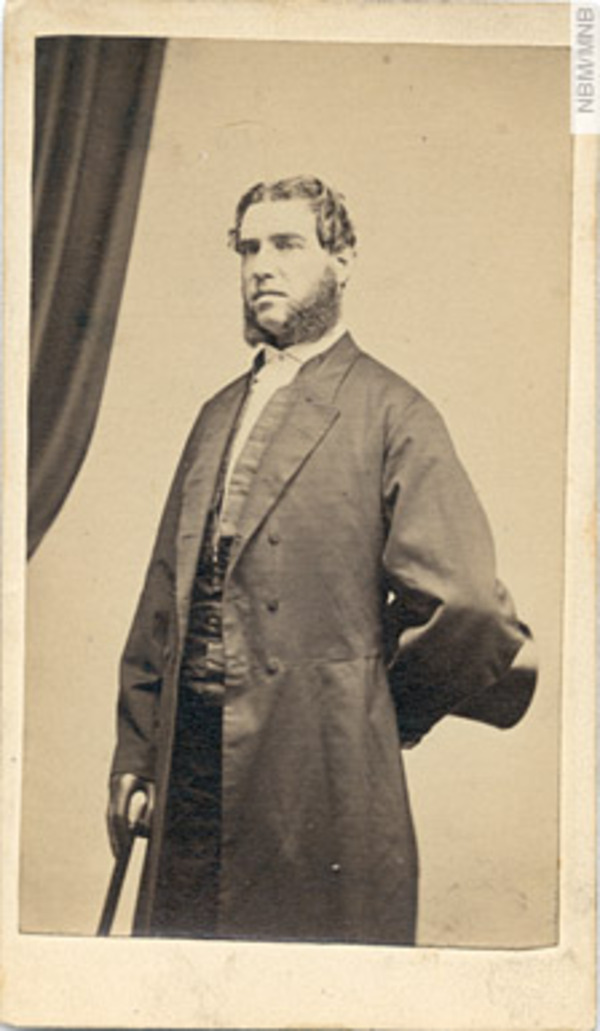
Source: Link
PETERS, BENJAMIN LESTER, merchant, militia officer, politician, and justice of the peace; b. 29 June 1790 in Grimross (Gagetown), N.B., son of James Peters and Margaret Lester; m. 26 June 1823 Mary Ann Winnett in Annapolis Royal, N.S., and they had six daughters and four sons; d. 12 May 1852 in Saint John, N.B.
In 1783 James Peters, a prominent loyalist from Long Island, N.Y., arrived in the future province of New Brunswick as an agent for the Associated Loyalists and personally acquired grant P11 in Parrtown (Saint John). He gained virtual control over what was to become the community of Grimross when he obtained a grant of 360 acres in that location the following year. Peters planned and colonized the Grimross region, and he represented it in the House of Assembly until 1816, four years before his death. Benjamin Lester Peters, second last child in a family of ten, apparently received some formal education before leaving Grimross for Saint John. A freeman of that city in 1813, he was an established merchant on the lower end of South Market Wharf by the early 1820s, selling china, glass, paint, homespun, tallow, and whatever else trade demanded.
An Anglican, Peters served as both a vestryman and a churchwarden of Trinity Church in Saint John. He was also an active member of the masonic order, belonging to Saint John’s Albion Lodge No.52. In 1826 he became the district grand master and deputy provincial grand master of the Grand Lodge of Free and Accepted Masons of New Brunswick. A son of the same name continued this connection into the 1890s. Peters was involved in the militia; a major of the 1st Battalion of Saint John militia in 1826, he was eventually appointed lieutenant-colonel commandant of the entire Saint John militia on 26 May 1845, the highest rank available to him.
Among Benjamin’s siblings, Charles Jeffery* became solicitor general of New Brunswick in 1825 and three years later succeeded Thomas Wetmore*, a brother-in-law, as attorney general for life; Harry was a member of the Council; Valentine H. became a judge of the Inferior Court of Common Pleas for Queens County; and William Tyng served as clerk of the Legislative Council. Through the marriages of his brothers and sisters, moreover, Benjamin was related not only to the Wetmores but also to such prominent families as the Ludlows and the Odells. These connections undoubtedly furthered his own political career. After serving for several years on the Saint John Common Council “with highly commendable zeal and activity,” he was appointed mayor of the city in April 1834, an office in the gift of the Executive Council of the province. During his year as mayor, Peters strongly supported the building of the harbour bridge linking the east and the west sides of the city, and he was named first in the act incorporating the construction company in 1835. On 7 Aug. 1837, when the bridge was almost completed, it collapsed, killing seven workers.
Early in August 1849 Peters was made a stipendiary magistrate for Saint John, a position created earlier that year by the revision of the city’s charter. According to the attorney general, Lemuel Allan Wilmot*, the office was “the most important one” proposed in the legislation, which consolidated several of the smaller municipal courts and was responsible for creating the city’s first police force (30 constables under the authority of the magistrate). Peters received an annual salary of £300 and had the right to name a clerk who would be paid £150. Benjamin Lester Peters Jr filled that position. Over the next two and a half years Peters Sr established the force on a firm footing and upheld the law, receiving much credit in his obituary notice in May 1852 for the “present peaceable status of our city [compared] with its former disorderly condition.” On 12 May 1852 he had died at home after a lingering illness.
N.B. Museum, Jack Connell, geneal. notes, Peters family of Gagetown; Reg. of marriages for the city and county of Saint John, book A (1810–28), 1823. Loyalist and Protestant Vindicator (Saint John, N.B.), 15 May 1852. Morning News (Saint John), 1849, 14 May 1852. New-Brunswick Courier, 1834–35; 15 May 1852. Star (Saint John), 18 June 1822. N.B. almanac, 1851. W. F. Bunting, History of St. John’s Lodge, F. & A.M. of Saint John, New Brunswick, together with sketches of all masonic bodies in New Brunswick from A.D. 1784 to A.D. 1894 (Saint John, 1895), 81–83, 86. D. R. Jack, Centennial prize essay on the history of the city and county of St. John (Saint John, 1883). Lawrence, Judges of N.B. (Stockton and Raymond).
Cite This Article
Carl M. Wallace, “PETERS, BENJAMIN LESTER,” in Dictionary of Canadian Biography, vol. 8, University of Toronto/Université Laval, 2003–, accessed December 22, 2025, https://www.biographi.ca/en/bio/peters_benjamin_lester_8E.html.
The citation above shows the format for footnotes and endnotes according to the Chicago manual of style (16th edition). Information to be used in other citation formats:
| Permalink: | https://www.biographi.ca/en/bio/peters_benjamin_lester_8E.html |
| Author of Article: | Carl M. Wallace |
| Title of Article: | PETERS, BENJAMIN LESTER |
| Publication Name: | Dictionary of Canadian Biography, vol. 8 |
| Publisher: | University of Toronto/Université Laval |
| Year of publication: | 1985 |
| Year of revision: | 1985 |
| Access Date: | December 22, 2025 |



